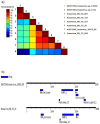Multiple clades of Husavirus in South America revealed by next generation sequencing
- PMID: 33755700
- PMCID: PMC7987173
- DOI: 10.1371/journal.pone.0248486
Multiple clades of Husavirus in South America revealed by next generation sequencing
Abstract
Husavirus (HuV) is an unclassified virus of the order Picornavirales that has already been identified worldwide in various locations. The genetic, epidemiological, and pathogenic characteristics are, however, little understood. In children with acute gastroenteritis, this study used next-generation sequencing to recognize unknown sources of viruses. In particular, 251 fecal samples obtained from individuals were sequenced in southern, northeastern, and northern Brazil. all samples were also analyzed using culture methods and parasitological tests to classify other enteric pathogens such as bacteria, parasites, and viruses. 1.9% of the samples tested positive for HuV, for a total of 5 positive children, with a mean age of 2 year, with three males and two females. Detailed molecular characterization of full genomes showed that Brazilian HuVs' nucleotide divergence is less than 11%. The genetic gap between Brazilian sequences and the closest HuV reported previously, on the other hand, is 18%. The study showed that Brazilian sequences are closely related to the HuV defined in Viet Nam in 2013, further characterization based on phylogenetics. At least two divergent clades of HuV in South America were also seen in the phylogenetic study.
Conflict of interest statement
The authors have declared that no competing interests exist.
Figures


Similar articles
-
Genome of a husavirus from Southern Brazil.Rev Inst Med Trop Sao Paulo. 2023 Jan 16;65:e5. doi: 10.1590/S1678-9946202365005. eCollection 2023. Rev Inst Med Trop Sao Paulo. 2023. PMID: 36651466 Free PMC article.
-
The Husavirus Posa-Like Viruses in China, and a New Group of Picornavirales.Viruses. 2020 Sep 7;12(9):995. doi: 10.3390/v12090995. Viruses. 2020. PMID: 32906743 Free PMC article.
-
Viral gastroenteritis in Tocantins, Brazil: characterizing the diversity of human adenovirus F through next-generation sequencing and bioinformatics.J Gen Virol. 2020 Dec;101(12):1280-1288. doi: 10.1099/jgv.0.001500. Epub 2020 Oct 12. J Gen Virol. 2020. PMID: 33044150
-
Molecular characterization of the first Aichi viruses isolated in Europe and in South America.Arch Virol. 2006 Jun;151(6):1199-206. doi: 10.1007/s00705-005-0706-7. Epub 2006 Jan 19. Arch Virol. 2006. PMID: 16421634
-
Clinico-epidemiology and genetic diversity of Salivirus in acute gastroenteritis cases from Pune, Western India: 2007-2011.Infect Genet Evol. 2016 Oct;44:425-430. doi: 10.1016/j.meegid.2016.07.047. Epub 2016 Aug 2. Infect Genet Evol. 2016. PMID: 27491456
Cited by
-
RNA-Seq Virus Fraction in Lake Baikal and Treated Wastewaters.Int J Mol Sci. 2023 Jul 27;24(15):12049. doi: 10.3390/ijms241512049. Int J Mol Sci. 2023. PMID: 37569424 Free PMC article.
-
Genome of a husavirus from Southern Brazil.Rev Inst Med Trop Sao Paulo. 2023 Jan 16;65:e5. doi: 10.1590/S1678-9946202365005. eCollection 2023. Rev Inst Med Trop Sao Paulo. 2023. PMID: 36651466 Free PMC article.
-
First Detection and Characterization of Smacovirus in the Human Vagina in Two Sequential Samples over a Twelve-Day Interval.Viruses. 2024 Sep 30;16(10):1545. doi: 10.3390/v16101545. Viruses. 2024. PMID: 39459879 Free PMC article.
-
Composition of Eukaryotic Viruses and Bacteriophages in Individuals with Acute Gastroenteritis.Viruses. 2021 Nov 25;13(12):2365. doi: 10.3390/v13122365. Viruses. 2021. PMID: 34960634 Free PMC article.
References
Publication types
MeSH terms
LinkOut - more resources
Full Text Sources
Other Literature Sources
Miscellaneous

